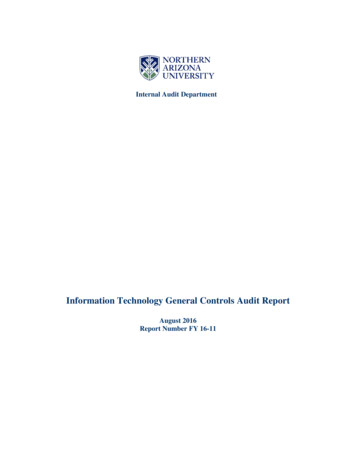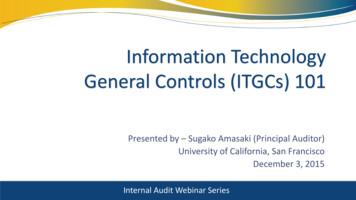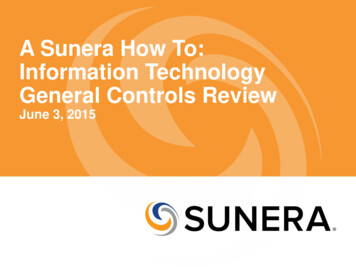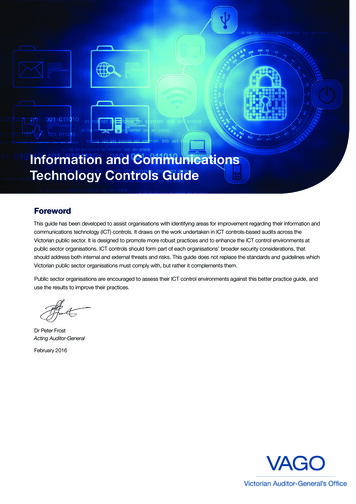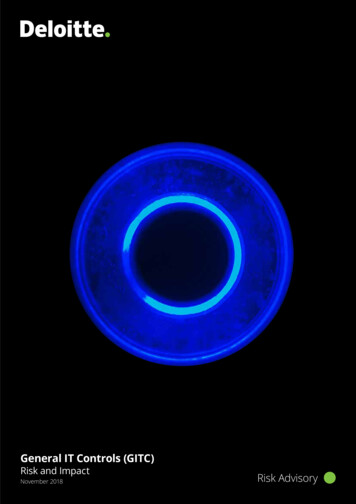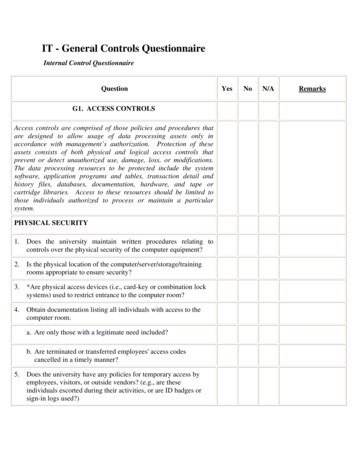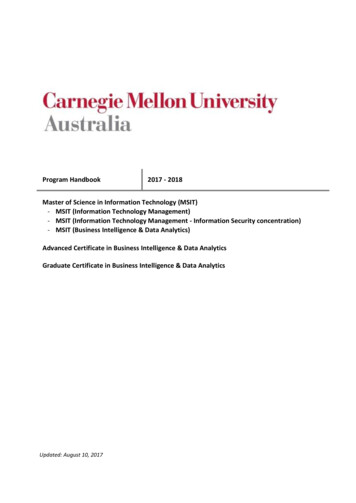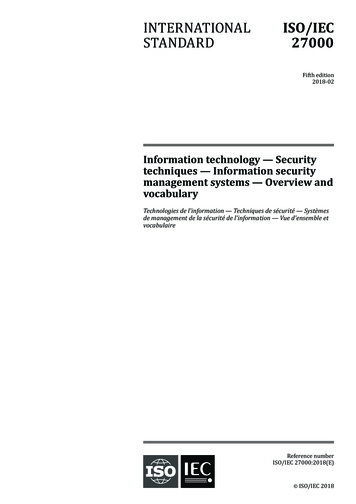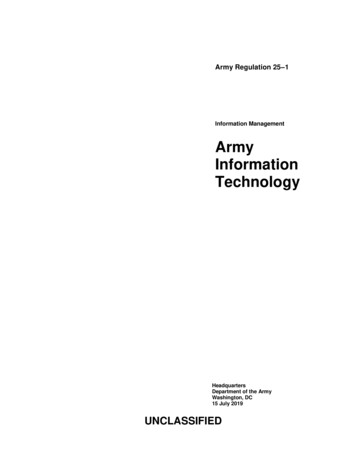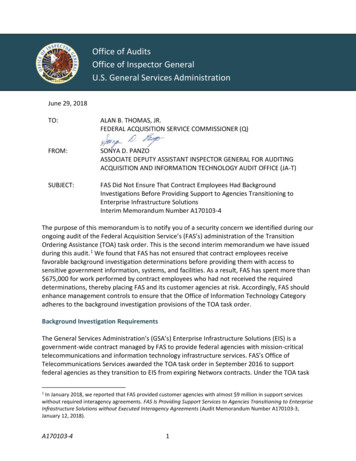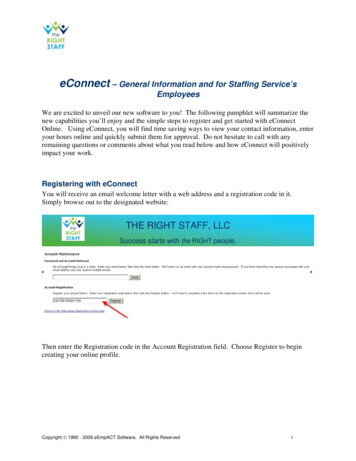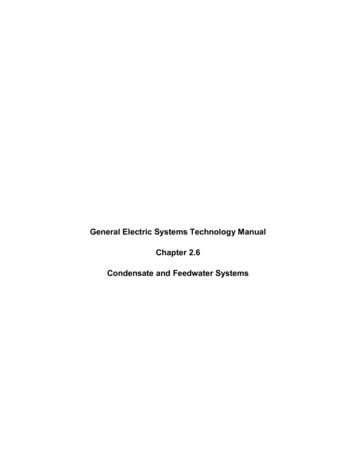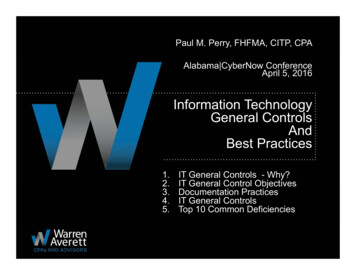
Transcription
Paul M. Perry, FHFMA, CITP, CPAAlabama CyberNow ConferenceApril 5, 2016Information TechnologyGeneral ControlsAndBest Practices1.2.3.4.5.IT General Controls - Why?IT General Control ObjectivesDocumentation PracticesIT General ControlsTop 10 Common Deficiencies
Presenter – Paul Perry, FHFMA, CITP, CPAPaul Perry has been with Warren Averett since2004 and is a Senior Manager in the Securityand Risk Consulting Division of Warren AverettTechnology Group – focusing on internal controland information technology related projects.Paul is also a member of the Firm’s DataAnalysis Group, a team of individuals within theFirm who provide data analysis solutions to bothinternal and external clients.For a number of years, he has specialized inaccounting advisory and review assuranceservices, as well as external and employeebenefit plan audits.Paul has extensiveexperience serving clients in the hcare facilities/hospital industries.
Warren Averett – Firm Facts
IT General Controls – Why?Key Risk AreasFinancialOperationsInformationSystemsSample Risk Assessment TypesFinancial RiskAssessmentCompliance RiskAssessmentFraud RiskAssessmentCyber RiskAssessmentCustomer andCredit RiskAssessmentSupply ChainRisk AssessmentProduct RiskAssessmentStrategic RiskAssessment
Information Technology General ControlsCOSO Model of Controls
IT General Control Objectives1. STRUCTURE AND STRATEGYEvaluate if reasonable controls over the Company’s Information Technologystructure are in place to determine if the IT Department is organized toproperly meet the Company’s business objectives.2. CHANGE MANAGEMENTEvaluate if reasonable controls are in place over change managementrelative to the operating systems and network environment to determine ifstandard maintenance changes (e.g. patches, fixes, upgrades, etc.) areidentified, approved, and tested prior to installation.3. VENDOR MANAGEMENTEvaluate if reasonable controls are in place over third‐party services todetermine if third‐party services are secure, accurate and available, supportprocessing integrity, and are defined in performance contracts.
IT General Control Objectives (Continued)4. SYSTEM & APPLICATION SECURITYEvaluate if reasonable controls are in place over system security, bothlogical and physical, to determine if software applications and the generalnetwork environment are reasonably secured to prevent unauthorizedaccess and appropriate environmental controls are in place.5. INCIDENT MANAGEMENTEvaluate if reasonable controls are in place over incident management torecord, investigate, and resolve any user or system incidents andmanagement monitoring of system incidents exists.6. DATA MANAGEMENTEvaluate if reasonable controls are in place over the data management andstorage process (backups and disaster recovery) ad are being tested on aregular basis.
Information Technology General ControlsDOCUMENTATION Who performs what?In what order are the controls performed?How often are they performed?Titles and not specific personnel. Personnel change.Key and Non-Key Controls Need a good mix of bothNon-key – process controls (how something is done anddocumented)Key – review controls (who reviews what others have done or majorcontrols – without this, something cannot be done)Can be manual or automated“If it is not documented, you did not do it”
Information Technology General ControlsPreventive – Detective – Corrective Preventive – prevent problems from occurring (Proactive) Segregation of Duties Monitoring Adequate Documentation Physical safeguards Detective – identify problems after occurrence (Reactive) Data Analytics Reviews Monitoring Corrective – prevent recurrence of problems Revisit the risk assessment process Change controls as needed to eliminate error in future.
Information Technology General Controls1 - STRUCTURE & STRATEGY Overall IT governance IT Strategy IT Steering Committee Are others involved outside IT (HR, C-Suite, etc.) Business Processes and Owners of Key Systems Structure of IT department Separate Security Department (sole focus on overall security)
Information Technology General Controls2 - PROGRAM CHANGE MANAGEMENT Change management policies and procedures Segregation of duties Separate test environment Testing over change process Authorization Testing Documentation Change management over operating systems and the network Review on periodic basis to baseline Database change management
Information Technology General Controls3 - VENDOR MANAGEMENT Vendor management policies Vendor listing and risk assessment Vendor Questionnaire Reviewing SSAE 16 (Service Organization Control) reports forvendors with access to clients network or holding clients data.
Information Technology General Controls4 - SYSTEM & APPLICATION SECURITY IT risk assessment Organization-wide or IT Specific Security policy and IT policies and procedures Acceptable Use Policy Network and financial application administrators Shared accounts limited Network and financial application password parameters UC/lc and Alphanumeric 8 Characters Changed every 90 days Remember last 5 logins Failed attempt lockout (3 attempts) – monitoring/logging Inactivity logout (15 mins)
Information Technology General Controls4 - SYSTEM & APPLICATION SECURITY - CONTINUED New hire and termination process Requests and approvals for access to different systems Acknowledge IT Acceptable Use Policy Notifications of terminations Termination checklist Local administrator access Logical access review Periodic (quarterly or annually) Who is reviewing – IT or department managers Unsupported versions of operating systems and software Firewall policies and administrators Reviewed periodically Updated with current technology
Information Technology General Controls4 - SYSTEM & APPLICATION SECURITY - CONTINUED Intrusion Prevention and Detection Systems Detect, log and analyze Identify incidents or potential incidents Prioritize based on impact Track and status of incidents How often are reports reviewed – consistently or weekly? Content and Spam Filtering Systems External penetration test and internal vulnerability scans Periodic (quarterly or annually) All IP addresses should be scanned Anti-virus monitoring and logging Remediation if items slip through
Information Technology General Controls4 - SYSTEM & APPLICATION SECURITY - CONTINUED VPN administrators Shared Accounts? VPN Dual Factor Authentication Password and company owned device or mobile phone Policies and access controls over portable devices Acknowledged by employees? Encryption on portable devices Ability to wipe remotely? Annual IT Security Training for all employees Document who attended and what was communicated Physical access and environmental controls over the ComputerFacility/Data Center Does entire organization have access or just IT department
Information Technology General Controls5 - INCIDENT MANAGEMENT System monitoring policies and proceduresSystem monitoring alertsHelp Desk policies and proceduresHelp Desk monitoring reports
Information Technology General Controls6 - DATA MANAGEMENT Data distribution policies Secure File Sharing Back-up policies and procedures Include record retention policies for different types Daily – 14 days, Monthly – 6 months, Annual – 7 years Back-up monitoring logs Restoration of back-up files Tested on regular basis Physical security over back-up tapes Transport log maintained Encryption of data backups Disaster recovery plan Disaster recovery testing – all systems vs critical applications
Top 10 Common Deficiencies1. Terminated employees still active in systems and the network2. Lack of segregation of duties over the development andproduction environment3. Lack of critical application list – no knowledge of vulnerabilities4. Lack of vendor management program and no vendor riskassessments5. Lack of external penetration testing and internal vulnerabilityscanning – cost or understanding6. Shared and/or generic administrator accounts without monitoring7. Weak system password parameters8. Outdated disaster recovery plan and no testing completed(financial applications and full IT network)9. Lack of data backup testing10. Lack of portable device policy and security
IT General Controls and Best PracticesQUESTIONS?Paul M. Perry, FHFMA, CITP, CPApaul.perry@warrenaverett.com(205) 769-3251
CPAs AND ADVISORSLET’S THRIVE TOGETHER
General Controls And Best Practices Paul M. Perry, FHFMA, CITP, CPA Alabama CyberNow Conference April 5, 2016 1. IT General Controls -Why? 2. IT General Control Objectives 3. Documentation Practices 4. IT General Controls 5. Top 10 Common Deficiencies. Presenter –Paul Perry, FHFMA, CITP, CPA PaulPerryhasbeenwithWarrenAverettsince 2004andisaSeniorManagerintheSecurity File Size: 397KBPage Count: 21
